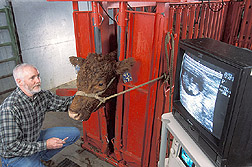This page has been archived and is being provided for reference purposes only. The page is no longer being updated, and therefore, links on the page may be invalid.
Fertility Study Looks at Ovulation's Intricate Workings
By Erin PeabodyMay 31, 2005
Agricultural Research Service (ARS) scientists are getting ever closer to finding out what makes animals tick reproductively. In efforts to boost fertility in beef cattle, researchers have discovered that the follicle—a tiny structure within a cow's ovary that releases the egg—must reach full maturity for pregnancy to have the best chance of success.
Pinpointing which hormonal cues enable the follicle to attain maturity is still keeping the scientists busy—but their findings are already important for livestock producers who would like to artificially inseminate all of their beef cows at the same time. The study could also shed light on issues concerning human fertility.
Tom Geary, a reproductive physiologist at ARS' Fort Keogh Livestock and Range Research Laboratory in Miles City, Mont., helped conduct the studies, along with reproductive physiologist Michael Smith at the University of Missouri-Columbia.
George Perry, a graduate student who worked with Geary and Smith before joining the Animal and Range Science Department at South Dakota State University in Brookings, once theorized that follicle size might be the best indicator of a cow's readiness to ovulate and establish a pregnancy.
But in a recent study, the researchers found that when cows were allowed to naturally ovulate, it didn't matter what size their follicles were—their bodies intuitively knew when the tiny, blisterlike structures were ready to release the eggs.
To induce ovulation in cows, beef producers administer the hormone known as GnRH. As the study points out, if the hormone is injected before a follicle is mature enough, pregnancy has a lower chance of success.
Follicular cells may not be fully developed at the time of induced ovulation because they're not producing enough estrogen, according to Geary. So he and other Ft. Keogh researchers are currently looking to see if extra estrogen helps coax follicle maturity along. This work could lead to higher fertility rates in industry artificial insemination programs.
The researchers' studies relating to follicle maturity were published recently in the Proceedings of the National Academy of Sciences.
ARS is the chief scientific research agency of the U.S. Department of Agriculture.

